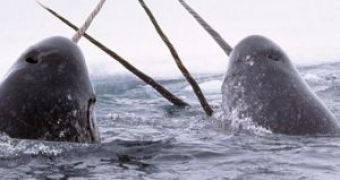Scientists have found preliminary evidence that narwhals (Monodon monoceros), Arctic cetaceans, produce signature vocalizations that may facilitate individual recognition or their reunion with more distant group members.
Narwhals are toothless but, despite this, they are closer to dolphins than the "true" whales. (Even the killer whale is in fact an oversized dolphin!). They don't have baleen plates. But males do possess just one tusk like tooth on the upper jaw. The tusk pierces through the upper lip and may be a secondary sexual trait or, as recent research suggests, a salinity sensor.
Before much was known about the animal, Vikings sold narwhals tusks which reached till Far East. The mystery of their origin triggered the myth of the unicorn. The tusk can be 10 feet long. (and the animal 16 feet). Narwhals live only in the Arctic Ocean and may live 40 years or more.
Their major predator is the killer whale, but they are also hunted traditionally by the Eskimos for their meat, fat and tusks.
Narwhal groups range from 5 to 30. They migrate thousands of miles in large numbers of many reunited individual groups moving in a coordinated fashion.
Scientists suppose that individual vocalizations help narwhals to recognize each other or reunite with distant mates, just like in human, when our relatives can identify us by voice without seeing us. It is long known that cetaceans rely on acoustic signaling for underwater communication.
Recent studies proved even the existence of dialects on whales populations. A recent study focused on the individual voices within a group.
A group at the Biology Department at the Woods Hole Oceanographic Institution (WHOI) managed to record the sounds of two adult male narwhals in Admiralty Bay on Baffin Island, Northern Canada in August 2004.
The team captured narwhals using fishing nets. Two adult males and one female were tagged with D-tags. This non-invasive tag was attached with suction cups and detached from the animal within hours. It contains a hydrophone (underwater microphone) but also pressure and movement sensors.
The two recovered spy tags revealed two individually distinctive vocalizations, including whistle and pulsed sounds.
"For the first time, we could really 'ride' with the animals as they were vocalizing and as they were moving," said Ari Shapiro of the WHOI.
The whistles, which have been shown to identify individual narwhals, and pulsed signals did not relate to foraging for food but rather to social communication, as the team supposes. "Many unanswered questions remain about narwhals, and understanding their vocal communication will provide insights into their social behavior," said Shapiro. "The individually distinctive pulsed/tonal signals and whistles may be a badge of group membership or a signal of individual recognition."
The distinctive vocalizations may have been produced by each animal to regain contact with other members of their group.
It was already known that bottlenose dolphins (Tursiops truncatus) produce signature whistle vocalizations, setting a precedent for this kind of communication system among long-lived social toothed whales and dolphins.

 14 DAY TRIAL //
14 DAY TRIAL // 
